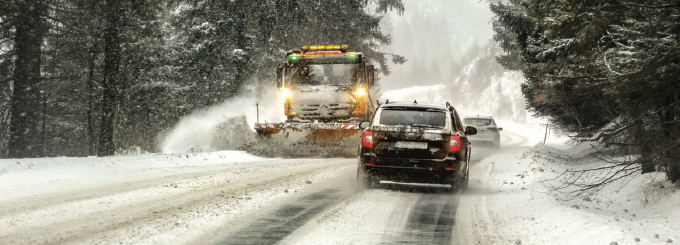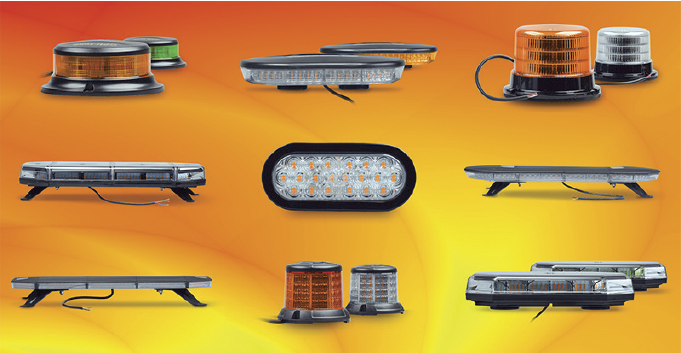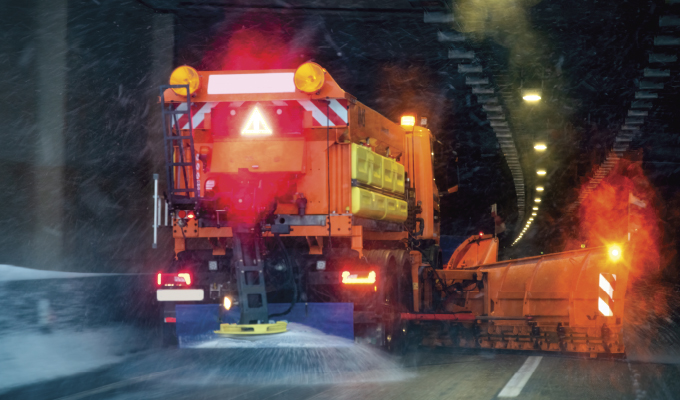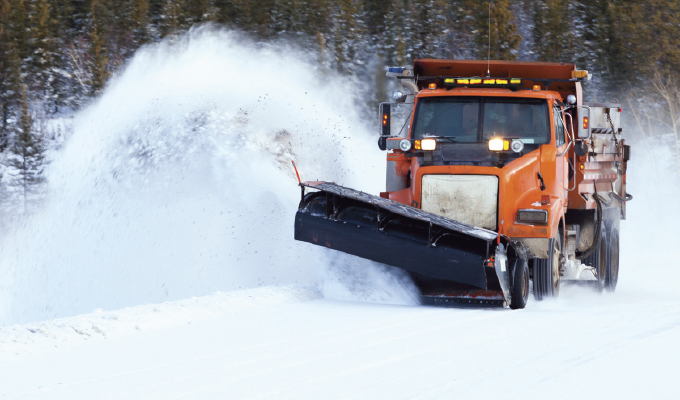According to the federal government, snow and ice are causal factors for over 500,000 motor vehicle crashes each year. This adds up to millions of dollars in property damage, vehicle downtime, personnel downtime, and worst of all, human injury or death. Additional reports also reveal increases in distracted driving (primarily due to mobile device use by drivers during vehicle operation) and increases in the average speed of vehicles year over year. Taken together, the statistics do not indicate a trend toward safer roadways—especially in winter climates. On the contrary, when you pack an increasingly hurried and distracted population of motorists together onto roadways with diminished visibility and reduced traction, the result is a less safe operational environment for snowplow operators.
CAUSE FOR CONCERN
A now-famous example of this unsafe environment occurred in January 2017. A plow driver named Terry Jacobson was run off the road by a semitruck while plowing US Route 6 in Spanish Fork Canyon, Utah. Jacobson, who had 23 years of plow truck experience, lost control when a semitruck driver tried to pass him and clipped him from behind, forcing him off the road. Another driver caught the incident with a dashboard camera. The Utah Department of Transportation (UDOT) subsequently used that footage to help create an awareness video to tell the story and ask motorists for increased attentiveness and caution around snowplows.
The video shows Jacobson cross oncoming traffic lanes on a curve after the semi makes contact. The snowplow then slices through a guardrail and disappears down a steep ridge. Footage and photos reveal the aftermath of the wrecked plow at the base of a 300-ft ravine. It was a harrowing nightmare, which Jacobson survived, albeit with significant injuries.
At around the 01:35 mark of the video, there is footage following behind another snowplow clearing a similar highway in hazardous winter conditions. Upon closer inspection of that sequence, it’s notable that there are only two relatively small, slow-flashing white signal lights visible at the back of the plow. While the truck in this setting is visible to the attentive observer, there is not an attention-grabbing presentation of warning lighting that demands visual attention and respect from careless or distracted motorists.

VISIBLE & RESPECTED
So the question for fleet managers is, “How do I keep my teams and equipment safe within the increasingly hostile surroundings of slippery roads, speeding cars, and unpredictable driving habits?” The answer to that question involves a variety of safety initiatives, including personnel training, equipment improvement, and advocating for the creation and enforcement of highway safety laws regarding snowplows.
However complex the issue of fleet safety can be during the winter months, one of the most crucial and economical first-step ways to improve safety is through better LED vehicle lighting installations.
Snowplow drivers need a “bright wall of warning lighting” that demands attention and respect from drivers. Lighting that’s merely visible isn’t enough. It’s likely the semitruck driver was able to see Jacobson’s snowplow in the center lane he was clearing. He just didn’t respect it. He felt he had the right to crowd the margin of safety while passing on a slippery curve.
Would more respect-demanding lights installed on the plow have caused the semi driver to think twice and slow down? Maybe. Maybe not. It’s true that, as any snowplow driver knows, some motorists seem hopelessly oblivious around work trucks.
Yet, research has shown that driver complacency is in fact affected by different types of safety lighting. Studies continue in the field of vehicle lighting performance and effect, but key takeaways from research combined with new LED technologies have opened new roads into staying not only visible, but respected, while working—and there are strategies to employ to achieve this respect.
EASY AS ABC
The goal of warning lights on a snowplow should be to send a clear message: This plow is on the job, and must be respected. Hashtag campaigns like #DontCrowdThePlow are great, but what would be the on-plow visual version of this social command? The answer is effective lighting. And like anything else involving safety technology, achieving the most effective snowplow lighting needs to begin with a strategy.
The lighting strategy for accomplishing visual respect isn’t overly complicated. It simply dictates that fleets must install numerous LED lights in multiple vehicle locations (in accordance with specific state light color laws), ensure optimum brightness, and provide flash pattern variability. This strategy can be remembered as “The ABCs of Warning Lighting”: All-over, Bright, and Changing.
- A: All-over. Position lights in many vehicle positions for complete sightline coverage.
- B: Bright. Make sure your lumens cut through bad weather and visibility at any time of day.
- C: Changing. Have dynamic and/or variable flash patterns because change commands attention.

NOW’S THE TIME
It can feel like a daunting task to plan snowplow safety lighting to achieve the goal of high visibility and respect. Like the ABCs listed above, a few additional purchasing guidelines for what makes the brightest and best lights can help. First and foremost, it’s essential to choose the best lighting supplier to make sure your fleet is not only commanding respect today, but is also ready to adapt and change in response to increased driver distraction and new levels of visual clutter on the roadways (bright lights are everywhere these days).
The LED vehicle lighting experts at Opti-Luxx have some thoughts on moving the ball forward on snowplow lighting safety with this simple set of principles to remember when making warning lighting decisions:
- Better warning lighting means rugged and reliable lighting because a failed warning light doesn’t warn anyone of anything.
- Better lighting means flash pattern options, giving drivers the ability to make scenario-based determinations to provide the safest and most effective lighting.
- Better lighting means simplicity of installation and always supported by a strong customer service team.
Turning to a supplier who has led the way in LED school bus lighting for nearly 20 years makes perfect sense when looking to make fleets more visible and therefore more respected and safe. Opti-Luxx General Manager Frank Li adds, “When school districts choose a lighting supplier like Opti-Luxx to make their bus fleets command attention and keep kids safe, snowplow fleet managers can be confident they’re giving their drivers the best LED lights available to stay visible, respected, and safe. We take that same bussing industry core belief that ‘Seeing is Safety’ and carry it forward to improve safety through the brightest and best lighting for snowplows, utility vehicles, delivery fleets, agricultural equipment, and all work truck applications.”
FOR MORE INFORMATION
Opti-Luxx is a full-service supplier of LED commercial vehicle lighting and offers customers product development, application engineering, program management, launch support for new and existing products, and service after the sale. Find out more, visit www.opti-luxx.com.




